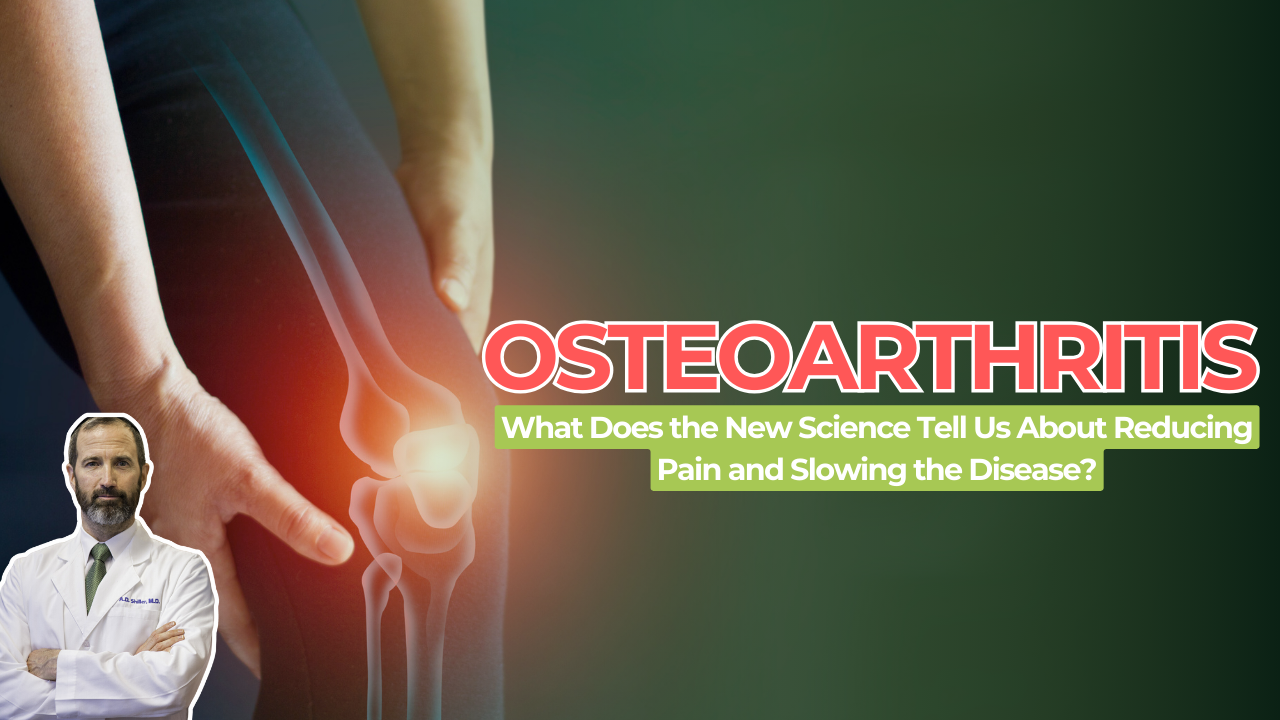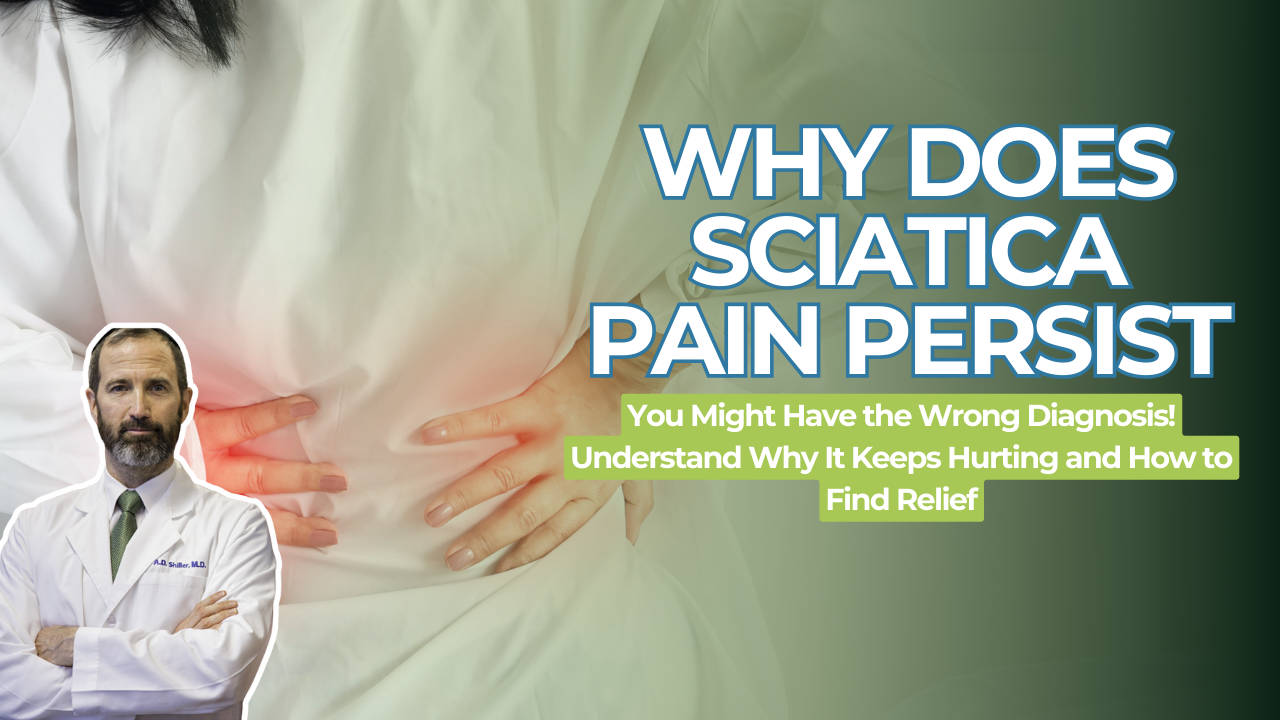Beating Chronic Pain and Illness
New Science of OA
Optimizing Wellness: Unlock Your Healing Potential with Integrative Pain Care.
For more videos subscribe to our YouTube channel here
SUMMARY
Are you suffering from persistent pain? Maybe you know someone who is? It’s an all-too-common problem, even among people who have gotten the best conventional medical care.
In this video, Dr. Shiller underscores the game-changing value of the integrative approach to pain, especially for individuals facing persistent pain challenges. During tens of thousands of patient encounters for over 20 years, he has refined a process of diagnoses and treatment that has helped where the best conventional medicine failed. Learn about the three key dimensions of integrative pain care: the motor-mechanical system, the biochemical-metabolic system, and the mind-body system. If you want the best result, you must consider these three systems and recognize their interconnection in creating, and healing, persistent pain. Even if you’ve tried everything, there is hope.
DID YOU KNOW?
- You can learn to reduce pain, improve mobility, and increase energy. Movement Toward Health is an affordable online training program that helps you heal and grow in a warm and inviting community. It opens periodically for new members. You can get more information and join the waitlist here: www.MTHTribe.com
- Do you want experienced, compassionate guidance in overcoming chronic pain or illness? Dr Shiller is available for telemedicine consultation worldwide regarding chronic pain, fibromyalgia, autoimmune disease, fatigue, and stress-related illness. Learn more here https://www.drshiller.com/consult
- Have you learned to mobilize your most important self-healing superpower? If you balance your stress/relaxation response, it could change your life. Dr Shiller gives regular free mind-body training sessions on zoom. Even if you “can’t meditate”, he has a way of helping. Learn practical tools for transforming pain and suffering, reducing stress and inflammation. Sessions are free. You can register at www.mindbodygroove.com
Related Posts
- Here’s How Autonomic Imbalance Drives Chronic Pain and Chronic Illness
- Dr Shiller’s Integrative Approach to Rehabilitation and Recovery after Trauma, Pain, Surgery, or Serious Illness
- Dr Shiller’s Integrative Approach to Pain
TRANSCRIPT
Hey, it’s Doctor Shiller, and I want to speak with you today about integrative pain management. This is gonna be really important if you or somebody you love is dealing with pain that has persisted despite the best medical care, or if you’re terrified of medical care and you don’t want to get those procedures and drugs, and you’re looking for alternatives.
It’s well known that very large numbers of people in the world, huge numbers of people, continue to suffer from ongoing pain despite the best medical care. And it’s also well known among those who know that there’s an approach called integrative pain management, which is a broader approach to pain care, broadening the diagnostic and therapeutic approaches beyond what’s typical in most clinics. And that when people go through that process, they often have better outcomes and get relief when conventional medical, orthopedic, or neurologic care didn’t help them. That’s part of why some of the best academic centers in America and in the world have integrative pain management programs.
So, I want to share a bit like a top-down overview of integrative pain management so that you get the idea that, well, maybe there is hope, maybe even if you think you’ve tried everything, maybe you haven’t, ’cause that’s been my experience over decades.
Just to give you a bit of background, I am not an alternative person. I’m a deeply scientifically grounded medical doctor who trained first in engineering at MIT and then in medical school and residency at Duke University and Harvard Medical School, where I specialized in physical medicine and rehabilitation, which is a non-operative approach to rehabilitation, pain management, helping people function better despite difficult chronic stuff.
My experience has been just like what the research and these academic centers know, which is that thousands of people have come to me who have said, “I have tried everything, and I’m stuck. What do I do?” And looking from an integrated point of view, finding therapeutic leverage and finding tools to actually help them.
So as a top-down view, what does that mean, integrative? The way I see it, the way I practice it, is that there’s three main aspects to it. There’s an integrative approach to your structure and mechanical motor system of your body. There’s an integrative approach to your biochemical and metabolic system of your body. There’s an integrative approach that involves your mind-body system.
So let’s unpack those all a little bit, right? Your motor structure, movement system, is your brain, your nerves, your muscles, your bones, your joints, your soft tissues, your fascia, your connective tissue, which is so important. That’s one of the things that we don’t really learn about in medical school. We get taught to dissect it out of the way so we can see “the important stuff,” but the fascia, the connective tissue, is actually a communication system.
It connects everything in your body, head to toes, bones to skin, wraps around your organs, your muscles, your nerves. It’s a massively important organ system unto itself. That’s why there’s been a fascia conference for a number of different years where scientists have come together to start studying fascia as its own thing.
Because the conventional view tends to look at bone, joint, nerve, disc as separate things. Okay, you injured your disc; let me fix your disc. Oh, you’re not getting better; what’s going on? They’re not necessarily looking at the way, well, you know, when the body forms, there is this deep layer of tissue in the middle of the embryo that differentiates into bone and nerve and muscle and connective tissue, and those things are in intimate relationship with each other. It’s one system.
And if you don’t think about it as one system, you miss the stuff that’s going on. So this is a huge topic unto itself, but basically, you could have an injury to your knee joint or your back; you could have a fracture, a nerve injury. Then your body responds to that; your neuromuscular system responds to that with guarding responses.
Your connective tissue system, your fascia, might get restricted or strained by the same injury. You might have a pattern of fascial strain that goes from your foot all the way up to your back, and even though they fixed your meniscus, you still have pain running down your leg. What’s that from? It’s from the integration of your entire system, your whole motor-muscular cell system. We address that through specific kinds of exercise, through hands-on manual treatment like osteopathy, highly skilled massage. We’re not talking about soft tissue; we’re talking about people who spent decades learning how to work with, diagnose, and manipulate all those tissues. Many physical therapists have advanced manual training; it’s a game-changer, and a lot of people just don’t know about it because docs don’t think about it. So that’s your motor mechanical system.
Let’s talk about the biochemical system. Two main principles here; there’s three. One of them is that a lot of docs aren’t really thinking about how nutrition and biochemistry and your degree of inflammation and cellular stress and biochemical stress or toxicity can influence the way your entire motor structural system works and can influence the way your pain processing works. So they’re not thinking about it critically, and if they are thinking and getting the basic labs to see about inflammatory markers, B12, vitamin D, these different things, they’re not thinking about how those things are involved in affecting pain transmission.
Again, a whole other topic in itself, but the point is that when I see somebody, I want to see all those labs; I want to know what’s going on because I’ve had that experience so many different times where there’s a synergy between subtle imbalances in biochemistry, in low-grade inflammation, in cellular stress that affects pain transmission and that affects neuromuscular function, that affects your brain and your mind and your emotions.
Your unity, everything’s connected to everything else. So the last part of this biochemical metabolic thing is your pain transmission system because it’s not like a wire you flip the switch. “Oh, my knees hurt; I have pain.” That signal gets processed in your spinal cord, in your mid-brain, in other parts of your brain by all sorts of different inputs, and there are things that turn that up like an amplifier or turn it down. Unless you have a doc who’s looking at that to see whether you have peripheral or central sensitization, you might not get a good outcome. So that’s part of what we do; we think about the sensitization, and we do various things to address it. More detail in another video, so check that out.
Third thing, the mind-body system, or maybe more appropriately called your body-emotion-mind-energy-spirit system because you are complex beyond imagining, and all of that relates to the biochemical bath in which your body exists, and the biochemistry of your body influences your mind-body experience.
And one of the classic examples is trauma and how many people come to me who had an injury five years before, who are still suffering, and no one’s asked them about the trauma and whether they have post-traumatic symptomatology, whether they can sleep, whether they’re still scared when they get into a car for years after a car accident, whether every time something reminds them of the traumatic experience, they start to shake or get afraid or sweat or their pain gets worse.
That’s post-traumatic stuff, and there’s ways to heal that on a more subtle level. It doesn’t have to be trauma; it can be grief, it can be chronic anxiety, it can be underlying traumatic experiences that are not vividly active but have primed or shifted the way your whole neurologic and bodily systems work. And by identifying those things over the years with my patients and encouraging and enabling them and empowering them to get appropriate therapy and shifting that underlying mind-body reality, we get good results, and they get better outcomes, and their pain gets better, and their function gets better.
So that’s an overview. You have these three dimensions: your muscular-motor-skeletal structural system, your biochemical-inflammatory-hormonal system, and your mind-body system. Good integrative pain management thinks about all that together in the context of the usual conventional diagnosis with a basis of a strong foundation underlying scientific principles and comes up with a more comprehensive therapeutic approach.
And that’s what’s given me the leverage to help hundreds, maybe thousands of people who were stuck, who said, “I’ve tried everything; there’s nothing that can help me.” Well, then we help them. So that’s been an honor and a joy and a privilege, and if this is interesting to you, I encourage you to go to my website, learn more, empower yourself with knowledge, and I wish you speedy, entirely fully healing of body, mind, and spirit. Thanks for watching.
Integrative Solutions for Sciatica: Addressing the Root Causes
For more videos subscribe to our YouTube channel here
SUMMARY
Did you know that the diagnosis of sciatica is often wrong? It’s true. And that’s why many people continue to suffer. Because if your diagnosis doesn’t identify the correct pain generator, then treatment is unlikely to help. “Sciatica” means irritation of the sciatic nerve. But there are many other structures that can be generating the pain. In this video, Dr. Shiller emphasizes the common misdiagnosis of sciatica and highlights the importance of an integrative approach for effective treatment. A hands-on examination by a qualified clinician is crucial to understanding the root cause. It’s also very important to consider and address biochemical imbalances and the mind-body connection when there is pain running down your leg. The best results come from an integrative pain management approach that considers structural, biochemical, and psychological factors for a comprehensive solution.
DID YOU KNOW?
- You can learn to reduce pain, improve mobility, and increase energy. Movement Toward Health is an affordable online training program that helps you heal and grow in a warm and inviting community. It opens periodically for new members. You can get more information and join the waitlist here: www.MTHTribe.com
- Do you want experienced, compassionate guidance in overcoming chronic pain or illness? Dr Shiller is available for telemedicine consultation worldwide regarding chronic pain, fibromyalgia, autoimmune disease, fatigue, and stress-related illness. Learn more here https://www.drshiller.com/consult
- Have you learned to mobilize your most important self-healing superpower? If you balance your stress/relaxation response, it could change your life. Dr Shiller gives regular free mind-body training sessions on zoom. Even if you “can’t meditate”, he has a way of helping. Learn practical tools for transforming pain and suffering, reducing stress and inflammation. Sessions are free. You can register at www.mindbodygroove.com
Related Posts
- Here’s How Autonomic Imbalance Drives Chronic Pain and Chronic Illness
- Dr Shiller’s Integrative Approach to Rehabilitation and Recovery after Trauma, Pain, Surgery, or Serious Illness
- Dr Shiller’s Integrative Approach to Pain
TRANSCRIPT
Hey, it’s Doctor Shiller.
I wanna speak briefly with you today about sciatica because so many people suffer with that symptom of pain from their butt or back going down their leg, and they’ve been told they have sciatica. For a lot of them, the diagnosis is just wrong, and they don’t get the right treatment. They don’t get better, and they continue to suffer because they got the wrong diagnosis. So let’s touch on what sciatica is and isn’t, and let’s talk about how an integrative approach frequently makes a difference and can take prolonged sciatica and get it better.
So for starters, I’m just letting you know where I’m coming from. I studied mechanical engineering at MIT and then I went to Duke University and Harvard Medical School for medical school and residency. So I really studied the best of conventional medicine as well as underlying biophysics and biology, and mechanics to really understand pain and the structure of your body.
And you know, sciatica refers to the sciatic nerve, and the sciatic nerve comes out of the lower lumbar nerve roots. There’s a diagram right here (I guess it’s probably there), so check out that diagram. It comes out of those roots and runs down and goes through your buttock and then runs down the back of your leg and splits into various other nerves all the way down to the bottom of your foot. So for sure, anywhere along that nerve, that nerve can get irritated. It can be the spinal roots; it can be in your butt where it goes through the piriformis muscle in some people. And from spasm in your butt muscle, you can actually get pain shooting down your leg. A lot of doctors don’t even know that. All they’re thinking about is, well, maybe you have a herniated lisk in your lower back. We should do some injections in your back, or maybe you need surgery. And they’re not thinking about the rest of the track of that nerve.
So it can be compressed in your buttock; it can also be irritated in the tissues themselves, depending on what kind of things have happened to the muscles and fascia and soft tissues of your lower leg. Because there are a lot of places you can have sciatica from things besides the sciatic nerve. If you have a bursitis in your greater trochanter on the outside of your hip or on your ischial bursa, which is kind of on the bottom of your pelvis, that can send pain down your leg. If you have chronic dysfunction of your fascia, whether it’s your psoas muscle in the core of your spine or higher up in your back, whether it’s in your buttock or the muscles of your lower back and the tissues, the fascia that invests them and connects them, bones to skin, head to toe, myofascial pain can start in your buttock or lower back and run down the back of your leg and seem like sciatica.
So the point is that there are different structures: your SI joint, your sacroiliac joint. When it gets dysfunctional, if it’s out of balance, there’s pain generators in there. And I’ve seen many cases where there was pain in the buttock going down the back, and we went and we sort of adjusted and balanced the SI joint in the pelvis, and like voila, the pain goes away.
So the first lesson to take home is that there’s a number of different structures in your lower back all the way down your leg that can generate that pain, and it can be the sciatic nerve or other things. And what’s really important is that you see a clinician who can do a really good hands-on exam and not just look at your X-ray or CT scan and say, oh, you got sciatica, there’s nothing to do for you because you don’t have a herniated disc that shows it or whatever the doctor says where they don’t have a solution. Don’t believe that! Find a qualified manual physical therapist or osteopath or physiatrist, a doctor who really knows how to do a good mechanical structural exam of the whole system and look in an integrative way at your muscle, bone, nerve, joint, structural system as one unit.
The other two pieces that are relevant for sciatica, which I have seen over and over again on my practice over the more than 20 years, is subtle biochemical imbalances, whether it’s nutrient deficiencies like vitamin B12 or vitamin D or magnesium, or whether it’s low-grade inflammation, biochemical stress, cellular stress, and toxicity. Those things can worsen the sensitivity of your pain system; they can increase the irritability of your muscles, predispose you to muscular or connective tissue spasm and restriction. Frequently, we fix those things, and that is synergistic with the issues that are going on through the connective tissue and the structural system of the body.
And then finally, your mind-body system is hugely important because that’s what processes pain; that’s what primes your body to its postural patterns. We talked a little bit about how the psoas, this big core muscle that runs down—well, here’s a picture of it—it inserts like at the bottom of your diaphragm where your ribs end and your lumbar spine starts and runs along your runner’s lumbar spine through your pelvis into your groin down your leg. This is one example when the psoas gets into spasm; you get pain shooting down into your groin, sometimes down your leg. It can seem like sciatica.
Not long ago, I saw someone who had really significant stressors and a significant trauma history prior that, and my experience just examining her was this twitchiness and irritability of her whole system. And when we started to talk about that history, she started to shake and cry, and she started to get pain in her leg. We brought it on by waking up that sort of difficult mind-body experience, and there’s ways to heal that, whether it’s through different kinds of psychotherapy, hands-on therapy, energy therapy. There are ways to heal and not just give drugs but to actually heal stressors, traumas, underlying grief, the things that can worsen pain or give rise to pain itself.
So that’s a little about sciatica. The key take-home points are that there are many different structural things besides the sciatic nerve, and you need to see someone who can actually put their hands on, understand the diagnosis, understand the CT scan and the MRI—what do those things really mean—but also do a hands-on exam and really feel and get a sense of what the structural driver or pain generator is. And then thinking about the biochemistry, the inflammation, and the mind-body system.
So that’s what I do; it’s integrative pain management. So I hope this has been interesting; I hope you share it. I hope you’re in touch, wishing you all the best.





